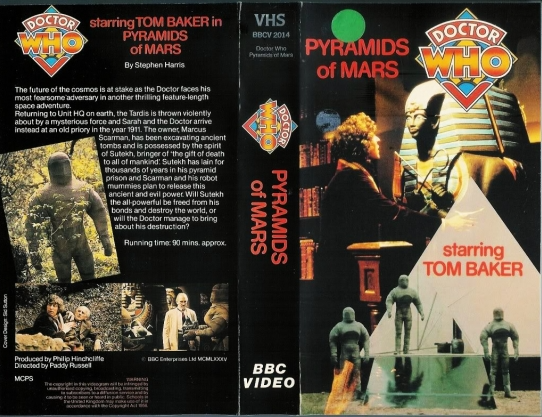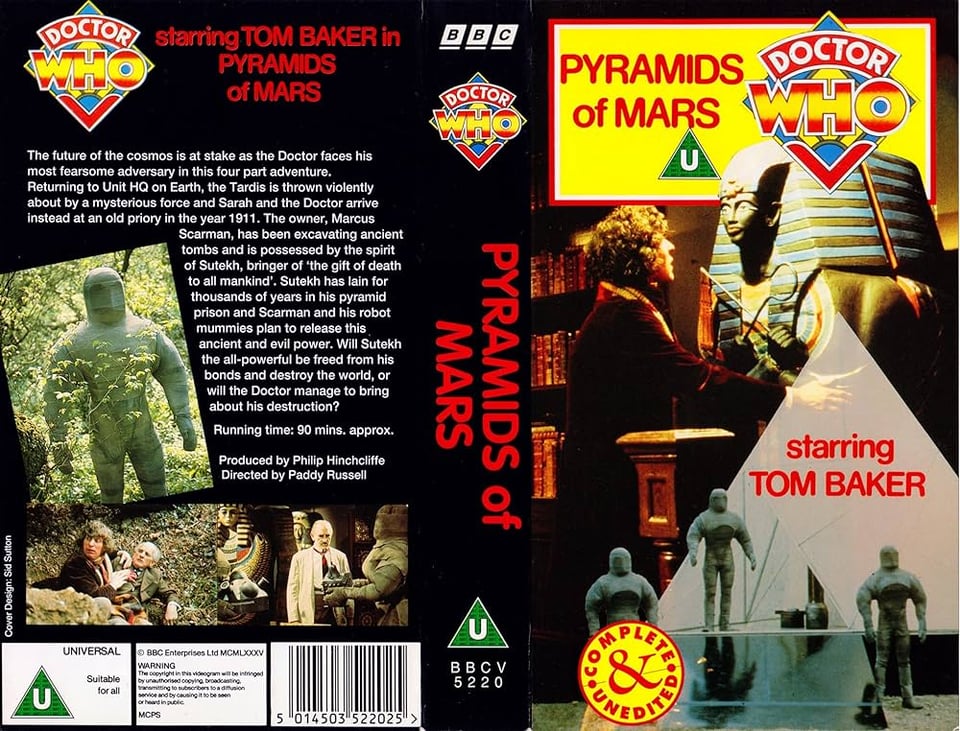"Only U Can Make The World Seem Right"
I have recently been wondering if there’s a “core canon” of twentieth century Doctor Who stories. I don’t mean that in the sense that Doctor Who fans usually mean the word “canon”, but instead something closer to Cambridge Don (and Terrance Dicks’ undergraduate tutor) FR Leavis’ notion of a “canonical text”. Closer. But not actually that. Because I don’t mean it in a gate-keeping way. There aren’t certain stories that one needs knowledge of in order to be an effective student of the series (if such a thing exists). There are just certain stories that are more prominent than others. Those that push their way into the consciousness of the wider fan audience, even of the general public as a whole.
You know the sort of stories I mean. They’ve probably been repeated a couple of times terrestrially or were early VHSes. Or both. Maybe they managed to be seen by upwards of 10m people or are the kind of thing that gets clipped and put into nostalgia shows to prompt genuflection rather than mockery. So Genesis of the Daleks (1975), Spearhead from Space (1970), The Five Doctors (1983). An Unearthly Child (1963) if not the rest of Serial A. The Daleks (1963/4) and The Dalek Invasion of Earth (1964), although in those cases perhaps filtered through their film adaptations, and strategic use of clips.
If such a “core canon” exists, and I’m not sure it does, Pyramids of Mars is surely within it. It’s one of the hardy perennials of Doctor Who fan top tens, and placed at #8 in a Doctor Who Magazine poll of the entire series as recently as 2014. It was well thought of by fans on transmission, when it handily won the Doctor Who Appreciation Society’s first ever series poll. It also became, when repeated in compilation form at the end of 1976, one of the handful of Doctor Who stories to be seen by more than 13m people and / or enter the weekly top ten all channels chart. (Yeah, it did both.)
Fan appreciation was certainly a factor in it subsequently being included as part of the BFI’s season of Doctor Who screenings in 1983, and that showing seems to have played a part in it becoming only the third BBC Doctor Who VHS release. It cost a frankly incredible £24.99 (that’s seventy five quid in 2024 money). Here’s a picture of it.

That original, mortgage-requiring VHS release was on 4th February 1985. Which is half way through The Mark of the Rani in Doctor Who terms. It was later re-released in the spring of 1987. This weirdly means the two cassettes effectively book end Pip and Jane Baker’s involvement in Doctor Who. Which is a meaningless coincidence I nevertheless find amusing. Although it is worth thinking about how much Doctor Who had had happen to (if not in) it in that interim.
Those two releases of Pyramids were of the same compilation version, one cut down into a single presentation of 90m 16s, with a single set of opening titles and a single set of closing credits, and with the cliffhanger reprises removed. Twelve of the first thirteen BBC Doctor Who VHS releases were treated in this way, the exception being The Five Doctors. Which was only an exception because it was made as a single 90m episode so didn’t have cliffhangers for anyone to remove.
One thing that The Five Doctors and Pyramids of Mars did share was that they had various other little pieces missing. The Five Doctors lost e.g. a shot of Richard Hurndall’s Doctor eating pineapple. I don’t have the space to describe and transcribe every change made to either story for VHS release, but if you want the full skinny, there’s a brilliant video about Pyramids by the astounding Pip Madeley here and I suggest you to watch it.
No, go watch it, then come back.
Done? Right.
As you can see, while some of Pyramids additional cuts are of the order of Hurndall’s pineapple, e.g. the trimming of a brief section of the opening stock footage establishing the serial’s (initial) Egyptian setting, others seem like they might have been done to reduce the horror / violent content of the serial, and there was widespread fan feeling at the time that this was what had been done. The cliffhangers to Parts One and Two of Pyramids of Mars are two of the most intense in all of Doctor Who, and both were lightly trimmed for the VHS. This was done, as Pip brilliantly illustrates (you have seen this, right?) by preferring action from the cliffhanger reprise rather than from the cliffhanger itself. In both cases, this results in a “milder” version of the scene being used. Simply because the reprise is a segue rather than a climax.
That could have been done deliberately, to make the scenes less intense, but it could also easily have been done in order to make editing the episodes down into a “film” an easier process. The “harsher” edits of the cliffhangers had the initial “scream” note of Doctor Who’s closing theme over them, while the “tamer” ones didn’t. This was still the days of physical analogue videotape copying and editing. (The initial attempted edit for something like this will have been done on paper, without reference to the actual tape at all.) Conveniently, they could take the sting out of the cliffhangers, both literally and metaphorically, with a single cut.
Fans, naturally, felt it had been denied the proper rough stuff that was their due as the adults they undoubtedly were. An earlier generation of comparisons was done, in part to the off-air soundtracks made during transmission in 1975, and through them it was confirmed that yes, there were bits missing! Scary bits! Violent bits! Censorship!
But was it? Censorship, I mean. Well, here some extra details are useful. The Video Recordings Act (1984) had received Royal Assent in July, but it wasn’t until 1985 that the BBFC, the ratings board that had had some role in categorising cinema films in Britain since 1912, was formally designated the authority for rating video recordings under the powers granted by the Act. Additionally, the Video Recordings (Labelling) Act, the one that actually meant that you had to have a ratings image, like the ones we’re all used to now, on the video box itself, wasn’t passed until later in 1985 than Pyramids’ VHS release. Which means that that initial release of Pyramids was released without a BBFC certificate, or rating on the packaging. (Scroll back up and see, if you don’t believe me.)
Even when the BBFC became responsible for rating video cassettes, it needed time to expand to a size able to cope with its workload now involving a whole new medium. There was also a backlog of tapes to rate as well as a burgeoning market of new releases to keep up with, and some clauses of the Video Recordings Act did not fully come into force until 1988.
Once the BBFC’s video rating operations were in full swing, the Pyramids of Mars compilation was classified U (Universal, Suitable for All). However, it’s simply not possible that Pyramids of Mars was cut in order to get a U certificate, because it was on shelves before the BBFC home video U certificate even existed. It was on sale at a point where the BBFC was only giving informal advice about video releases because it wasn’t yet legally responsible for them.
It was, incidentally, a good job Pyramids did get a U, as BBC Video policy at the time was that all Doctor Who releases had to carry a Universal certificate. This policy would run into difficulties in the immediate future. Of which more another time.
The commencement of the acts, and the requirement that all VHSes be visibly labelled with their BBFC ratings, were why that newly badged re-release of April 1987 happened. But the reissue was also cheaper, priced at £9.99 (a borderline reasonable twenty five quid in 2024 terms) which is just before the stories I’m currently covering in the The Long Way Round section of this newsletter.
So while it would be the new century before Doctor Who fans gained control of the series itself, by the 1980s fan response could drive things like the choice of BFI screenings, and make Pyramids an early VHS release, while the home video revolution itself delivered the story a new audience, one certainly smaller than that from the original transmission, while also considerably larger than the 450 people who can fit into NFT1 at the BFI. A new audience who could watch it not just once, or twice if there happened to be a repeat, but as many times as they liked.
This is perhaps why, by the late 1990s, Pyramids was almost the default Doctor Who serial full stop. It’s even the one featured in Russell T Davies’ Queer As Folk. Back when he was a writer who was known to be a Doctor Who fan, rather than twice the architect of the series’ restoration. That’s probably not why the serial came out on DVD between Davies’ revival of Doctor Who being announced and it actually getting to screen, but it’s as pleasing a coincidence as measuring out the VHS releases in Pip and Jane stories.
There was actually a final, unedited re-release of Pyramids of Mars on VHS, in February 1994. This was part of a deliberate 1990s programme of BBC Video righting the fan-perceived wrongs of their early years, and putting out “Complete and Unedited” editions of earlier VHSes. (Although at least one of them was still edited, just differently. By mistake.)
That unedited video release was a sort of accidental tie-in to a post 30th anniversary repeat of the story on BBC Two in early 1994. By then it was considered, despite its supposedly shocking, gory nature, to be suitable for a Sunday lunchtime slot, where it was seen by an average of 1m people a week. The VHS was re-certificated specially for the occasion by the BBFC, as it had to be by law due to being a different edit.
It was rated U.
